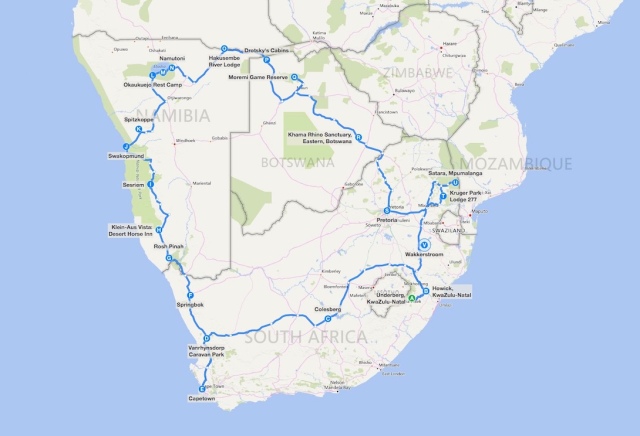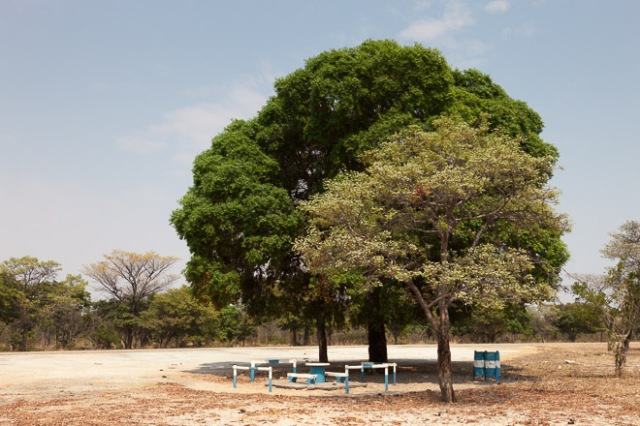Discussion
The concept of a journey can be depicted in various ways and I have chosen to do so with a series of images taken during an actual journey through South Africa, Namibia and Botswana at the end of 2017. Although I considered using more traditional ‘landscape’ images of the trip, I have in the end elected to use images of some of the ‘picnic’ spots or rest areas found along the road we travelled.
This series of images began with a different concept as I had planned to use images of these sites around South Africa to demonstrate the neglect and decay that is taking place in the infrastructure as well as the indiscriminate disposal of garbage. As a child we regularly stopped at these sites when going on holiday and they are a reminder of those times when they were typically well maintained and in good condition. The element related to throwing away one’s waste irresponsibly, is indicative of an attitude, that is becoming more prevalent today, of simply leaving it at the roadside or wherever else one chooses for somebody else to clean up. Examples of this initial concept are shown in the two images below.
During our journey, we experienced a wide variety of these picnic sites in a range of conditions and I was moved to capture these to convey the concept of the journey we had undertaken.
Journeys have been used by photographers in a variety of ways to develop their body of work.
Chris Coekin photographed the people that gave him a lift as well as incidental things he came across while hitchhiking. This meant that the people who appeared in his images were decided by those giving the lift and not the photographer.
Walker Evans, Robert Frank and Paul Graham also used the road to develop series. In Graham’s work along the A1 he has largely ignored recognisable landmarks.
Alec Soth travelled along the Mississippi River often focusing on the exotic characters along the route rather than landmarks. He says, ‘I began to think that the river itself could function as a metaphor for a kind of wandering’.
Nadav Kander uses the Yangtze to journey through China showing its hugely diverse topography and geography.
A trip, whether it is along a road or river, allows the traveller (photographer) the unique opportunity ‘to compare the many places and things that they pass quickly, and find both similarities and nuanced differences as they traverse different regions of the country’.
It is in this context that the viewer is able to consider the similarities and differences in this series of images of the picnic sites or rest areas along the roads of South Africa, Namibia and Botswana.
There is however also a second element to this work which relates to the typological genre of photography. The New Topographics exhibition in 1975 subverted the traditional concept of the ‘Landscape’ and considered in its place the ordinary and banal. It considered the manmade landscape rather than the picturesque and natural. Also, those that presented the typological concept, showed multiple views of similar subjects. The Bechers were leaders of this type of photography with their views of blast furnaces and coal processing plants. This methodology may be defined as one in which ‘a consistent technical rigour is applied to similar or particular types of subjects’. The effect of this is to ask the viewer to look carefully and identify the individualities within the images. This visual effect as seen in the Bechers work was described as follows:
‘The effect of this repeated pattern was very powerful. A single cooling tower may look beautiful, but nine cooling towers on one sheet looks like a series of ancient monoliths, or temples, or plinths for statues of long forgotten gods’. Paul Farley and Michael Symmons Roberts (2011; 194)
More recently, Donovan Wylie in his series on ‘The Maze’ and also ‘Outposts’ presents the viewer with similar images from inside the Maze Prison and of army watch towers asking the viewer to stop and look to see what is different.
The typological element of this series on ‘Picnic Sites’ asks the viewer to look carefully at the images and see how they differ from place to place.
Conclusion
This series of images allows the viewer to compare the images of picnic sites along a route from two differing perspectives. Firstly, to compare these places that are normally seen only fleetingly and understand the differences that occur in different regions. Secondly, the images can be viewed as a typology where the viewer would once again compare the images and look at the individualities within the images understanding their differences.
Bibliography
Farley, P, Roberts, M S ‘Edgelands: Journeys into England’s True Wilderness’ London: Jonathan Cape, 2011
Bell, R D https://dougsocalandscapeblog.wordpress.com/2017/12/14/exercise-2-3-typologies/
The image below shows the route travelled















